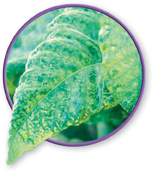20.1 Viruses
 How do viruses reproduce?
How do viruses reproduce? What happens after a virus infects a cell?
What happens after a virus infects a cell?
virus
capsid
bacteriophage
lytic infection
lysogenic infection
prophage
retrovirus
Venn Diagram Make a Venn diagram in which to record the similarities and differences between viruses and cells. Fill it in as you read the lesson.
MYSTERY CLUE

British scientists carefully investigated the veterinary histories of 169 cattle with BSE. All 169 had been given feed enriched with meat and bone meal protein from slaughtered cattle. How could this practice spread a disease?
THINK ABOUT IT Imagine that you have been presented with a great puzzle. Farmers have begun to lose their valuable tobacco crop to a plant disease that first appears as a yellowing of the leaves. Eventually the leaves wither and fall, killing the plant. To determine what is causing the disease, you take leaves from a diseased plant and crush them to produce a liquid extract. You place a few drops of that liquid on the leaves of healthy plants. A few days later, the leaves turn yellow where you put the drops.

You use a light microscope to look for a germ that might cause the disease, but none can be seen. In fact, when even the tiniest of cells are filtered out of the liquid, the liquid still causes the disease. You hypothesize that the liquid must contain disease-causing agents so small that they are not visible under the microscope and can pass right through the filter. Although you cannot see the tiny disease-causing particles, you're sure they are there. What would you do next? How would you deal with the invisible?
The Discovery of Viruses
 How do viruses reproduce?
How do viruses reproduce?
If you think you could have carried out the investigation described above, congratulations! You're walking in the footsteps of a 28-year-old Russian biologist, Dmitri Ivanovski. In 1892, Ivanovski demonstrated that the cause of this particular plant disease—called tobacco mosaic disease—was found in the liquid extracted from infected plants. But he could not pin down the culprit.
Discovery of Viruses In 1897, Dutch scientist Martinus Beijerinck suggested that tiny particles in the juice caused the disease, and he named these particles viruses, after the Latin word for “poison.” Then, in 1935, the American biochemist Wendell Stanley isolated crystals of tobacco mosaic virus. Living organisms do not crystallize, so Stanley inferred that viruses were not truly alive. This is a conclusion that biologists still recognize as being valid today. A virus is a nonliving particle made of proteins, nucleic acids, and sometimes lipids.  Viruses can reproduce only by infecting living cells.
Viruses can reproduce only by infecting living cells.

Table of Contents
- Formulas and Equations
- Applying Formulas and Equations
- Mean, Median, and Mode
- Estimation
- Using Measurements in Calculations
- Effects of Measurement Errors
- Accuracy
- Precision
- Comparing Accuracy and Precision
- Significant Figures
- Calculating With Significant Figures
- Scientific Notation
- Calculating With Scientific Notation
- Dimensional Analysis
- Applying Dimensional Analysis




